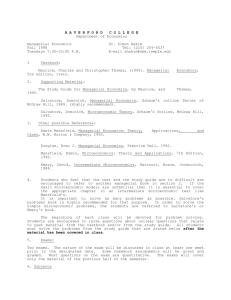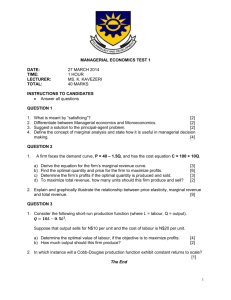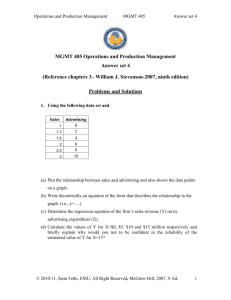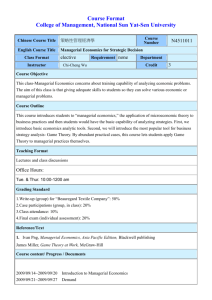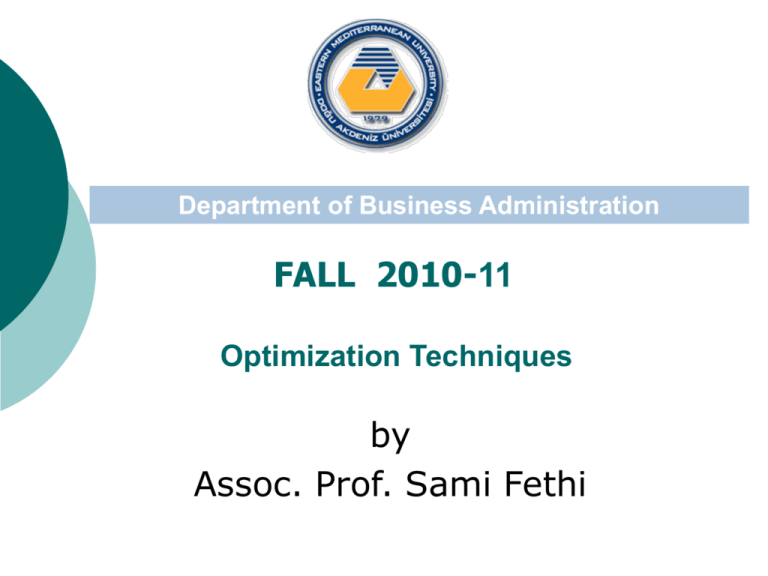
Department of Business Administration
FALL 2010-11
Optimization Techniques
by
Assoc. Prof. Sami Fethi
Ch 2: Optimisation Techniques
Optimization Techniques and New Management Tools
The first step in presenting optimisation
techniques is to examine ways to express
economic relationships. Economic relationship
can be expressed in the form of equation, tables,
or graphs. When the relationship is simple, a
table and/ or graph may be sufficient. However,
if the relationship is complex, expressing the
relationship in equational form may be
necessary.
2
Managerial Economics in a Global Economy
© Dominick Salvatore; ed. 2007, 2010/11, Sami Fethi, EMU, All Right Reserved.
Ch 2: Optimisation Techniques
Optimization Techniques and New Management Tools
Expressing an economic relationship in equational
form is also useful because it allows us to use the
powerful techniques of differential calculus in
determining the optimal solution of the problem.
More importantly, in many cases calculus can be
used to solve such problems more easily and with
greater insight into the economic principles underlying
the solution. This is the most efficient way for the firm
or other organization to achieve its objectives or reach
its goal.
3
Managerial Economics in a Global Economy
© Dominick Salvatore; ed. 2007, 2010/11, Sami Fethi, EMU, All Right Reserved.
Ch 2: Optimisation Techniques
Example 1
Suppose that the relationship between the total
revenue (TR) of a firm and the quantity (Q) of the
good and services that firm sells over a given
period of time, say, one year, is given by
TR= 100Q-10Q2
(Recall: TR= The price per unit of commodity times
the quantity sold; TR=f(Q), total revenue is a
function of units sold; or TR= P x Q).
4
Managerial Economics in a Global Economy
© Dominick Salvatore; ed. 2007, 2010/11, Sami Fethi, EMU, All Right Reserved.
Ch 2: Optimisation Techniques
Example 1
By substituting into equation 1 various
hypothetical values for the quantity sold, we
generate the total revenue schedule of the firm,
shown in Table 1. Plotting the TR schedule of
table 1, we get the TR curve as in graph 1. In
this graph, note that the TR curve rises up to
Q=5 and declines thereafter.
5
Managerial Economics in a Global Economy
© Dominick Salvatore; ed. 2007, 2010/11, Sami Fethi, EMU, All Right Reserved.
Ch 2: Optimisation Techniques
Example 1
TR = 100Q - 10Q2
Equation1:
Table1:
Q
TR
0
0
1
90
2
3
4
5
6
160 210 240 250 240
TR
300
Graph1:
250
200
150
100
50
0
0
1
2
3
4
5
6
7
Q
6
Managerial Economics in a Global Economy
© Dominick Salvatore; ed. 2007, 2010/11, Sami Fethi, EMU, All Right Reserved.
Ch 2: Optimisation Techniques
Example 2
Suppose that we have a specific relationship
between units sold and total revenue is precisely
stated by the function: TR= $ 1.50 x Q. The
relevant data are given in Table 2 and price is
constant at $ 1.50 regardless of the quantity sold.
This framework can be illustrated in graph 2.
7
Managerial Economics in a Global Economy
© Dominick Salvatore; ed. 2007, 2010/11, Sami Fethi, EMU, All Right Reserved.
Ch 2: Optimisation Techniques
Example 2
Revenue per tim e
period
Graph of the relationship betw een total revenue and
units sold
9
7.5
6
4.5
3
1.5
0
1
2
3
4
5
6
Unit Sold
TR
Price
1
1.5
1.5
2
3
3
4.5
4
6
5
7.5
6
9
Unit sold for time period
Graph2:
Table2:
8
Managerial Economics in a Global Economy
© Dominick Salvatore; ed. 2007, 2010/11, Sami Fethi, EMU, All Right Reserved.
Ch 2: Optimisation Techniques
Total, Average, and Marginal Cost
The relationship between total, average, and
marginal concepts and measures is crucial in
optimisation analysis. The definitions of totals
and averages are too well known to warrant
restating, but it is perhaps appropriate to define
the term marginal.
A marginal relationship is defined as the
change in the dependent variable of a function
associated with a unitary change in one of the
independent variables.
9
Managerial Economics in a Global Economy
© Dominick Salvatore; ed. 2007, 2010/11, Sami Fethi, EMU, All Right Reserved.
Ch 2: Optimisation Techniques
Total, Average, and Marginal Cost
In the total revenue function, marginal revenue is
the change in total revenue associated with a oneunit change in units sold. Generally, we analyse an
objective function by changing the various
independent variables to see what effect these
changes have on the dependent variables. In other
words, we examine the marginal effect of changes
in the independent variable. The purpose of this
analysis is to determine that set of values for the
independent or decision variables which optimises
the decision maker’s objective function.
Managerial Economics in a Global Economy
10
© Dominick Salvatore; ed. 2007, 2010/11, Sami Fethi, EMU, All Right Reserved.
Ch 2: Optimisation Techniques
Total, Average, and Marginal Cost
(Recall: Total cost: total fixed cost plus total variable costs;
Marginal cost: the change in total costs or in total variable
costs per unit change in output).
Table3:
AC = TC/Q
MC = TC/Q
Managerial Economics in a Global Economy
Q
0
1
2
3
4
5
TC AC MC
20 140 140 120
160 80 20
180 60 20
240 60 60
480 96 240
11
© Dominick Salvatore; ed. 2007, 2010/11, Sami Fethi, EMU, All Right Reserved.
Ch 2: Optimisation Techniques
Total, Average, and Marginal Cost
The first two columns of
Table
3
present
a
hypothetical
total
cost
schedule of a firm, from
which the average and
marginal cost schedules are
derived in columns 3 and 4
of the same table. Note
that the total cost (TC) of
the firm is $ 20 when
output (Q) is zero and rises
as output increases (see
graph 3 to for the graphical
presentation
of
TC).
Average cost (AC) equals
total
cost
divided
by
output. That is AC=TC/Q.
Thus, at Q=1, AC=TC/1=
$140/1= $140. At Q=2,
AC=TC/Q =160/2= £80
and so on. Note that AC
first falls and then rises.
Table3:
Q
0
1
2
3
4
5
TC AC MC
20 140 140 120
160 80 20
180 60 20
240 60 60
480 96 240
12
Managerial Economics in a Global Economy
© Dominick Salvatore; ed. 2007, 2010/11, Sami Fethi, EMU, All Right Reserved.
Ch 2: Optimisation Techniques
Total, Average, and Marginal Cost
Marginal cost (MC), on the other
hand, equals the change in total cost
per unit change in output. That is,
MC= TC/Q where the delta ()
refers to “a change”. Since output
increases by 1unit at a time in column
1 of table 3, the MC is obtained by
subtracting successive values of TC
shown in the second column of the
same table. For instance, TC increases
from $ 20 to $ 140 when the firm
produces the first unit of output. Thus
MC= $ 120 and so forth. Note that as
for the case of the AC and MC also
falls first and then rises (see graph 4
for the graphical presentation of both
AC and MC). Also, note that at Q=3.5
MC=AC; this is the lowest AC point.
At Q=2; that is the point of inflection
whereas the point shows MC at the
lowest point.
Managerial Economics in a Global Economy
Table3:
Q
0
1
2
3
4
5
TC AC MC
20 140 140 120
160 80 20
180 60 20
240 60 60
480 96 240
13
© Dominick Salvatore; ed. 2007, 2010/11, Sami Fethi, EMU, All Right Reserved.
Ch 2: Optimisation Techniques
Total, Average, and Marginal Cost
T C ($ )
Graph3:
240
180
120
60
0
0
1
2
3
4
Q
MC
A C , M C ($ )
AC
120
Graph4:
60
0
0
1
2
3
4
Q
14
Managerial Economics in a Global Economy
© Dominick Salvatore; ed. 2007, 2010/11, Sami Fethi, EMU, All Right Reserved.
Ch 2: Optimisation Techniques
Profit Maximization
Table 4 indicates the relationship between TR, TC and
Profit. In the top panel of graph 5, the TR curve and the
TC curve are taken from the previous graphs. Total
Profit () is the difference between total revenue and
total cost. That is = TR-TC. The top panel of Table 4
and graph 5 shows that at Q=0, TR=0 but TC=$20.
Therefore, = 0-$20= -$20. This means that the firm
incurs a loss of $20 at zero output. At Q=1, TR=$90
and TC=$ 140. Therefore, = $90-$140= -$50. This is
the largest loss. At Q=2, TR=TC=160. Therefore, = 0
and this means that firm breaks even. Between Q=2
and Q=4, TR exceeds TC and the firm earns a profit.
The greatest profit is at Q=3 and equals $30.
15
Managerial Economics in a Global Economy
© Dominick Salvatore; ed. 2007, 2010/11, Sami Fethi, EMU, All Right Reserved.
Ch 2: Optimisation Techniques
Profit Maximization
Q
0
1
2
3
4
5
TR
0
90
160
210
240
250
TC Profit
20
-20
140
-50
160
0
180
30
240
0
480 -230
Table 4:
Managerial Economics in a Global Economy
Table
4 indicates the relationship
between TR, TC and Profit. In the
top panel of graph 5, the TR curve
and the TC curve are taken from the
previous graphs. Total Profit () is
the difference between total revenue
and total cost. That is = TR-TC.
The top panel of Table 4 and graph 5
shows that at Q=0, TR=0 but
TC=$20. Therefore, = 0-$20= -$20.
This means that the firm incurs a
loss of $20 at zero output. At Q=1,
TR=$90 and TC=$ 140. Therefore,
= $90-$140= -$50. This is the
largest loss. At Q=2, TR=TC=160.
Therefore, = 0 and this means that
firm breaks even. Between Q=2 and
Q=4, TR exceeds TC and the firm
earns a profit. The greatest profit is
at Q=3 and equals $30.
16
© Dominick Salvatore; ed. 2007, 2010/11, Sami Fethi, EMU, All Right Reserved.
Ch 2: Optimisation Techniques
Profit Maximization
Graph5:
($)
300
TC
240
TR
180
MC
120
60
MR
0
Q
0
1
2
3
4
5
60
30
0
-30
Profit
-60
17
Managerial Economics in a Global Economy
© Dominick Salvatore; ed. 2007, 2010/11, Sami Fethi, EMU, All Right Reserved.
Ch 2: Optimisation Techniques
Optimization by marginal Analysis
Marginal analysis is one of the most important
concepts in managerial economics in general
and in optimisation analysis in particular.
According to marginal analysis, the firm
maximizes profits when marginal revenue
equals marginal cost (i.e. MC=MR). Here, MC
is given by the slope of TC curve and this
tangential point is the point of inflection (i.e. at
Q=2).
18
Managerial Economics in a Global Economy
© Dominick Salvatore; ed. 2007, 2010/11, Sami Fethi, EMU, All Right Reserved.
Ch 2: Optimisation Techniques
Optimization by marginal Analysis
Graph5:
MR can be defined as the change
in total revenue per unit change
in output or sales (i.e.
MR=TR/Q) and is given by
the slope of the TR curve. In
graph 5, at Q=1 the slope of TR
or MR is $80. At Q=2, the slope
of TR or MR is $60. At Q=3 or
4, the slope of TR curve or MR
is $40 and $20 respectively. At
Q=5, the TR curve is highest or
has zero slope so that MR=0.
After that TR declines and MR is
negative.
($) 300
TC
240
TR
180
MC
120
60
MR
0
Q
0
1
2
3
4
5
60
30
0
-30
Profit
-60
19
Managerial Economics in a Global Economy
© Dominick Salvatore; ed. 2007, 2010/11, Sami Fethi, EMU, All Right Reserved.
Ch 2: Optimisation Techniques
Optimization by marginal Analysis
Also At Q=3, the slope of the
TR curve or MR equals the
slope of TC curve or MC, so
that the TR curves are
parallel and the vertical
distance between them () is
greatest. In the top panel of
graph 5, at Q=3, MR=MC
and is at a maximum. In
the bottom panel of graph 5,
the total loss of the firm is
greatest when function
faces up whereas the firm
maximizes its total profit
when function faces down.
Managerial Economics in a Global Economy
Graph5:
($) 300
TC
240
TR
180
MC
120
60
MR
0
Q
0
1
2
3
4
5
60
30
0
-30
Profit
-60
20
© Dominick Salvatore; ed. 2007, 2010/11, Sami Fethi, EMU, All Right Reserved.
Ch 2: Optimisation Techniques
Example-TP
Given the following total
product (TP) schedule, (a)
drive the average product
(AP) and marginal product
(MP) schedules. (b) On the
same set of axes plot the
total,
average,
and
marginal product schedules
of part a. (c) Using the
figure you drew for part b,
briefly
explain
the
relationship among the
total,
average,
and
marginal product curves.
Table-TP
Q
0
1
2
3
4
5
6
7
TP
0
3
8
12
15
17
17
16
21
Managerial Economics in a Global Economy
© Dominick Salvatore; ed. 2007, 2010/11, Sami Fethi, EMU, All Right Reserved.
Ch 2: Optimisation Techniques
Answer-TP-(a)
Q
TP
AP
MP
0
0
-
-
1
3
3
3
2
8
4
5
3
12
4
4
4
15
3.75
3
5
17
3.4
2
6
17
2.8333333
0
7
16
2.2857143
-1
22
Managerial Economics in a Global Economy
© Dominick Salvatore; ed. 2007, 2010/11, Sami Fethi, EMU, All Right Reserved.
Ch 2: Optimisation Techniques
Answer-TP-(b)
total average marginal
product
Schedule
20
15
TP
10
AP
5
MP
0
-5
0
1
2
3
4
5
6
7
quantity
23
Managerial Economics in a Global Economy
© Dominick Salvatore; ed. 2007, 2010/11, Sami Fethi, EMU, All Right Reserved.
Ch 2: Optimisation Techniques
Answer-TP-(c)
The slope of a ray from the origin to the TP curve or the average
product rises to a point between 2 and 3. then after 5 start to fall
but it remains positive as long as TP is positive. Thus the AP
curve rises to a point between 2 and 3 and then declines. At the
same time, the slope of the TP curve (i.e. The marginal product)
rises to the point 1.5 (i.e. The point of inflation of the TP curve
and falls thereafter. Thus the MP curve rises to the intersection
point of TP and MP and then declines. When TP is at its
maximum, the slope of the TP curve is zero (i.e. top point of TP)
and so is MP intersection point on horizontal axis. Past point (i.e.
top point of TP) , TP curve declines and MP is negative. It is
important to mention that when the AP curve rises, the MP
curve is above it and when the AP curve declines and MP curve
is below it. The MP curve intersects the AP curve at the highest
point of AP so that AP=MP at the level of ouput.
24
Managerial Economics in a Global Economy
© Dominick Salvatore; ed. 2007, 2010/11, Sami Fethi, EMU, All Right Reserved.
Ch 2: Optimisation Techniques
Example-TR
Given Px=8-Qdx
(a) Drive (calculate) TR, AR, MR.
(b) Plot the schedules of part a.
(c) Using the figure you drew for part b, briefly explain the
relationship among the total, average, and marginal revenue
curves.
Table-TR
P
8
7
6
5
4
3
2
1
0
Q
25
Managerial Economics in a Global Economy
© Dominick Salvatore; ed. 2007, 2010/11, Sami Fethi, EMU, All Right Reserved.
Ch 2: Optimisation Techniques
Answer-TR-(a)
P
Q
TR
AR
MR
8
0
0
7
1
7
7
7
6
2
12
6
5
5
3
15
5
3
4
4
16
4
1
3
5
15
3
-1
2
6
12
2
-3
1
7
7
1
-5
0
8
0
0
-7
26
Managerial Economics in a Global Economy
© Dominick Salvatore; ed. 2007, 2010/11, Sami Fethi, EMU, All Right Reserved.
Ch 2: Optimisation Techniques
Answer-TR-(b)
Plot
MR-TR-AR
20
15
10
TR
5
0
AR
-5
MR
0
1
2
3
4
5
6
7
8
-10
quantity
27
Managerial Economics in a Global Economy
© Dominick Salvatore; ed. 2007, 2010/11, Sami Fethi, EMU, All Right Reserved.
Ch 2: Optimisation Techniques
Answer-TR-(c)
The slope of a ray from the origin to the TR curve or
the average revenue rises to a point between 1 and 3.
then after 4 start to fall but it remains positive as long
as TR is positive. Thus the AR curve declines from
1.5 to 7.5. At the same time, The marginal revenue
curve decreases and intersect the horizontal axis at 5.
When TR is at its maximum, the slope of the TR
curve is zero (i.e. top point of TR) and so is MR
intersection point on horizontal axis. Past point (i.e.
top point of TR) , TR curve declines and MR is
negative. It is important to mention that when the AR
curve declines, the MR curve is below it. The MR
curve intersects the AR curve at the highest point of
AR so that AR=MR at the level of ouput.
28
Managerial Economics in a Global Economy
© Dominick Salvatore; ed. 2007, 2010/11, Sami Fethi, EMU, All Right Reserved.
Ch 2: Optimisation Techniques
Concept of the Derivative
Graph 6:
The concept of derivative is
closely related to the concept of
the margin. This concept can be
explained in terms of the TR
curve of graph1, reproduced with
some modifications in graph6.
Earlier, we defined the marginal
revenue as the change in total
revenue per unit change in
output. For instance, when
output increases from 2 to 3
units, total revenue from $160 to
$ 210. Thus, MR= TR/ Q = $
210-$ 160/3-2 =$ 50.
Managerial Economics in a Global Economy
29
© Dominick Salvatore; ed. 2007, 2010/11, Sami Fethi, EMU, All Right Reserved.
Ch 2: Optimisation Techniques
Concept of the Derivative
This is the slope of chord BC on the
total-revenue curve. However,
when Q assumes values smaller
than unity and as small as we want
and even approaching zero in the
limit, then MR is given by the slope
of shorter chords, and it approaches
the slope of the TR curve at a point
in the limit. Thus, starting from
point B, as the change in quantity
approaches zero, the change in total
revenue or marginal revenue
approaches the slope of the TR
curve at point B. That is MR= TR/
Q = $ 60- the slope of tangent BK
to the TR curve at point B as
change in output approaches zero in
the limit.
Managerial Economics in a Global Economy
Graph 6:
30
© Dominick Salvatore; ed. 2007, 2010/11, Sami Fethi, EMU, All Right Reserved.
Ch 2: Optimisation Techniques
Concept of the Derivative
To summarize between points B and C
on the total revenue curve of graph 6, the
marginal revenue is given by the slope of
chord BC ($ 50). This is average
marginal revenue between 2 and 3 units
of output. On the other hand, the
marginal revenue at point B is given by
the slope of line BK ($ 60), which is
tangent to the total revenue curve at
point B. For example, at point C, MR is
$ 40. Similarly, at point D, MR= $20
whereas at point E, MR= $ 0- when total
revenue curve reflect its concave shape
its slope is always zero and then the
shape indicates declining slope.
Graph 6:
31
Managerial Economics in a Global Economy
© Dominick Salvatore; ed. 2007, 2010/11, Sami Fethi, EMU, All Right Reserved.
Ch 2: Optimisation Techniques
Concept of the Derivative
Graph 6:
32
Managerial Economics in a Global Economy
© Dominick Salvatore; ed. 2007, 2010/11, Sami Fethi, EMU, All Right Reserved.
Ch 2: Optimisation Techniques
Concept of the Derivative
In general, if we let TR=Y and Q=X, the derivative of Y
with respect to X is given by the change in Y with respect
to X, as the change in X approaches zero. So we define this
concept in the following expression.
The derivative of Y with respect to X is equal to
the limit of the ratio Y/X as X approaches
zero.
33
Managerial Economics in a Global Economy
© Dominick Salvatore; ed. 2007, 2010/11, Sami Fethi, EMU, All Right Reserved.
Ch 2: Optimisation Techniques
Concept of the Derivative-Example
Suppose we have y=x2
dY lim
X 0
dX
dY
dX
2xdx-+ x2 +dx2 - x2
dX
lim (2xdx)
X
dY
dX
lim f(x+dx)- f(x)
X 0
dX
lim (x+dx)2- x2
X
2x
dX
34
Managerial Economics in a Global Economy
© Dominick Salvatore; ed. 2007, 2010/11, Sami Fethi, EMU, All Right Reserved.
Ch 2: Optimisation Techniques
Rules of Differentiation
Constant Function Rule: The derivative of a
constant, Y = f(X) = a, is zero for all values of
a (the constant).
Y f (X ) a
dY
0
dX
For example, Y=2 dY/dX=0
the slope of the line Y is zero.
35
Managerial Economics in a Global Economy
© Dominick Salvatore; ed. 2007, 2010/11, Sami Fethi, EMU, All Right Reserved.
Ch 2: Optimisation Techniques
Rules of Differentiation
Power Function Rule: The derivative of a
power function, where a and b are
constants, is defined as follows.
Y f (X ) aX b
dY
b a X b 1
dX
For example, Y=2x
dY/dX=2
36
Managerial Economics in a Global Economy
© Dominick Salvatore; ed. 2007, 2010/11, Sami Fethi, EMU, All Right Reserved.
Ch 2: Optimisation Techniques
Rules of Differentiation
Sum-and-Differences Rule: The derivative of the sum or
difference of two functions U and V, is defined as
follows.
U g( X )
V h( X )
Y U V
dY dU dV
dX dX dX
For example:
U=2x and V=x2
Y=U+V=2x+ x2
dY/dX=2+2x
37
Managerial Economics in a Global Economy
© Dominick Salvatore; ed. 2007, 2010/11, Sami Fethi, EMU, All Right Reserved.
Ch 2: Optimisation Techniques
Rules of Differentiation
Product Rule: The derivative of the product of two
functions U and V, is defined as follows.
U g( X )
V h( X )
Y U V
dY
dV
dU
U
V
dX
dX
dX
For example:Y=2 x2 (3-2 x)
and let U=2 x2 and V=3-2 x
dY/dX=2x2(dV/dX)+(3-2x)(dU/dX)
dY/dX=2 x2(-2)+ (3-2 x) (4x)
dY/dX=-4x2+ 12x+8 x2
dY/dX= 12x-12 x2
38
Managerial Economics in a Global Economy
© Dominick Salvatore; ed. 2007, 2010/11, Sami Fethi, EMU, All Right Reserved.
Ch 2: Optimisation Techniques
Rules of Differentiation
Quotient Rule: The derivative of the ratio of two
functions U and V, is defined as follows.
For example:
Y=3-2x/2x2
and let V=2 x2 and U=3-2 x
dY/dX=(2 x2(dV/dX)+ (3-2 x) (dU/dX))/v2
dY/dX=2 x2(-2)+ (3-2 x) (4x)/ (2 x2)2
dY/dX=4x2-12/4x4= (4x)(x-3)/ (4x) (x3)=x-3/x3
U g( X )
V h( X )
U
Y
V
dY
dX
V dU
dX
U dV
V
dX
2
39
Managerial Economics in a Global Economy
© Dominick Salvatore; ed. 2007, 2010/11, Sami Fethi, EMU, All Right Reserved.
Ch 2: Optimisation Techniques
Rules of Differentiation
Chain Rule: The derivative of a function that is a
function of X is defined as follows.
Y f (U )
U g( X )
dY dY dU
dX dU dX
For example:
Y=U3+10 and U=2X2
then dY/dU=3U2 and dU/dX=4X
dY/dX=dY/dU.dU/dX=(3U2) 4X
dY/dX=3(2X2)2(4X)=48X5
40
Managerial Economics in a Global Economy
© Dominick Salvatore; ed. 2007, 2010/11, Sami Fethi, EMU, All Right Reserved.
Ch 2: Optimisation Techniques
Optimization With Calculus
Find X such that dY/dX = 0 minimum or maximum.
First order is necessary not sufficient for min or max
Second derivative rules:
If d2Y/dX2 > 0, then X is a minimum.
If d2Y/dX2 < 0, then X is a maximum.
For example:
TR=100-10Q2
d(TR)/dQ=100-20Q
Setting d(TR)/dQ=0, we get
100-20Q=0
Q=5-This means that its slope is zero and total revenue is
maximum at the o/p level of 5 units.
41
Managerial Economics in a Global Economy
© Dominick Salvatore; ed. 2007, 2010/11, Sami Fethi, EMU, All Right Reserved.
Ch 2: Optimisation Techniques
Optimization With Calculus
Distinguishing between a Maximum and a Minimum:
The second derivative
For example:
TR=100-10Q2
d(TR)/dQ=100-20Q
d2(TR)/dQ2=-20
The rule is if the derivative is
positive, we have a minimum,
and if the second derivative is
negative,
we
have
a
maximum. This means that
TR function has zero slope at
5. Since d2(TR)/dQ2=-20, this
TR function reaches a
maximum at Q=5.
42
Managerial Economics in a Global Economy
© Dominick Salvatore; ed. 2007, 2010/11, Sami Fethi, EMU, All Right Reserved.
Ch 2: Optimisation Techniques
Maximizing a Multivariable Function
To maximize or minimize a multivariable
function, we must set each partial
derivative equal to zero and solve the
resulting set of simultaneous equations
for the optimal value of independent or
right-hand side variables.
43
Managerial Economics in a Global Economy
© Dominick Salvatore; ed. 2007, 2010/11, Sami Fethi, EMU, All Right Reserved.
Ch 2: Optimisation Techniques
Example-Profit
=80X-2X2-XY-3Y2+100Y - total profit function
We set d/dX and d/dY equal to zero and solve for X and Y as well as .
d/dX=80-4X-Y=0
d/dY=-X-6Y+100=0
Multiplying the first of the above expression by –6, rearranging the second
and adding, we get
-480+24X+6Y=0
100-X-6Y=0
-380=23X=0
X=16.52
Y=13.92
and substituting the values of x and y into the profit equation mentioned
above, we have the max total profit of the firm is $ 1,356.52.
44
Managerial Economics in a Global Economy
© Dominick Salvatore; ed. 2007, 2010/11, Sami Fethi, EMU, All Right Reserved.
Ch 2: Optimisation Techniques
Constrained optimisation
Example-substitution and Lagrangian Multiplier Methods
Suppose that a firm seeks to maximize its total profit
and the function as follows:
=80X-2X2-XY-3Y2+100Y
but faces the constrain that the o/p of commodity X plus
the o/p of commodity Y must be 12. That is, X+Y=12
First we can write X as a function of Y, such as X=12-Y
And substituting X=12-Y into the profit function in
inspection.
Finally, we get: =-4Y2+56Y+672
45
Managerial Economics in a Global Economy
© Dominick Salvatore; ed. 2007, 2010/11, Sami Fethi, EMU, All Right Reserved.
Ch 2: Optimisation Techniques
Example-substitution and Lagrangian Multiplier Methods
Solving y, we find the first derivative of: with respect
to Y and then set it equal to zero,
d/dY=-8Y+56=0 Y=7 and X=5 and the profit is
=80X-2X2-XY-3Y2+100Y=$868.
Example for lagrangian method
Suppose that we have a Lagrangian function as
follows:
Lagrangian=profit fuction +(constraint function is set
to equal to zero)
L=80X-2X2-XY-3Y2+100Y+(X+Y-12)
46
Managerial Economics in a Global Economy
© Dominick Salvatore; ed. 2007, 2010/11, Sami Fethi, EMU, All Right Reserved.
Ch 2: Optimisation Techniques
Example-substitution and Lagrangian Multiplier Methods
First we have to find the partial derivative of L with respect to X,Y, and and
setting them equal to zero:
dL/dX=80-4X-Y+=0
(1)
dL/dY=-X-6Y+100+=0
(2)
dL/d=X+Y-12=0
(3)
First subtract eq2 from eq1 and get
–20-3X+5Y=0
(4)
Now, multiplying eq3 by 3 and adding with eq4 and get the followings
3X+3Y-36=0
-3X+5Y-20=0
8Y-56=Y=7
X=5 into eq2 to get the value of
-X-6Y+100+=0
=X+6Y-100
=-53 (economic interpretation?)
The total profit of the firm increase or decrease by about $ 53
In order to find the total profit of the firm, subs the relevant figures ($868)
Managerial Economics in a Global Economy
47
© Dominick Salvatore; ed. 2007, 2010/11, Sami Fethi, EMU, All Right Reserved.
Ch 2: Optimisation Techniques
Example-Profit function
For the following total profit function of a firm:
2y2-120y+xy = 144x --3x2 -35
Determine
(a) the level of output of each commodity at
which the firm maximizes its profit.
(b) the value of maximum amount of the total
profit of the firm.
48
Managerial Economics in a Global Economy
© Dominick Salvatore; ed. 2007, 2010/11, Sami Fethi, EMU, All Right Reserved.
Ch 2: Optimisation Techniques
Answer-Profit function
For the following total profit function of a firm:
2y2-120y+xy = 144x --3x2 -35
(a) d/dx=144-6x-y=0, d/dy=-x-4y+120=0
x= 19.82 and y=25.04
(b) 2(25.04)2-120 (25.04)+(19.82)(25.049 = 144 (19.82)--3 (19.82)2 -35
=$ 2,895.09
49
Managerial Economics in a Global Economy
© Dominick Salvatore; ed. 2007, 2010/11, Sami Fethi, EMU, All Right Reserved.
Ch 2: Optimisation Techniques
Example-TR/TC
For the following total revenue and cost functions:
TR=22Q-0.5Q2 and
TC=(1/3) Q3- 8.5Q2 +50Q+90
Determine
(a) the level of output of Q commodity at which the firm
maximizes its profit.
(b) the value of maximum amount of the total profit of
the firm.
(c) Explain briefly part a and b
50
Managerial Economics in a Global Economy
© Dominick Salvatore; ed. 2007, 2010/11, Sami Fethi, EMU, All Right Reserved.
Ch 2: Optimisation Techniques
Answer-TR/TC
For the following total revenue and cost functions:
TR=22Q-0.5Q2 and
TC=(1/3) Q3- 8.5Q2 +50Q+90
(a)=TR-TC
= 22Q-0.5Q2-((1/3) Q3- 8.5Q2 +50Q+90)
= -1/3 Q3 + 8 Q2 -28Q-90
d/dQ= - Q2 + 16 Q2 -28Q
Q1 = 14 Q2=2
(b) = -1/3 (14)3 + 8 (14)2 -28 (14)-90
=$ 171.4
(c) profit is max as Q=14 and min as Q=2.
d2/dQ2= -2 Q +16=0
(14) for -12 Max; (2) for 12 Min.
51
Managerial Economics in a Global Economy
© Dominick Salvatore; ed. 2007, 2010/11, Sami Fethi, EMU, All Right Reserved.
Ch 2: Optimisation Techniques
New Management Tools
Benchmarking
Total Quality Management
Reengineering
The Learning Organization
52
Managerial Economics in a Global Economy
© Dominick Salvatore; ed. 2007, 2010/11, Sami Fethi, EMU, All Right Reserved.
Ch 2: Optimisation Techniques
Other Management Tools
Broadbanding
Direct Business
Model
Networking
Pricing Power
Small-World Model
Virtual Integration
Virtual Management
53
Managerial Economics in a Global Economy
© Dominick Salvatore; ed. 2007, 2010/11, Sami Fethi, EMU, All Right Reserved.
Ch 2: Optimisation Techniques
The End
Thanks
54
Managerial Economics in a Global Economy
© Dominick Salvatore; ed. 2007, 2010/11, Sami Fethi, EMU, All Right Reserved.


